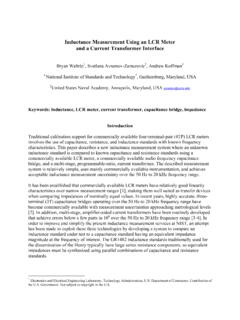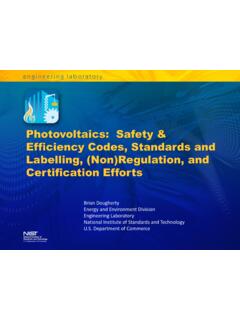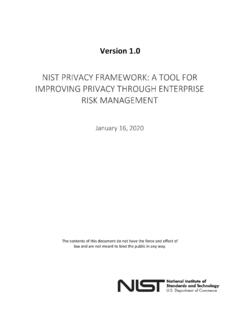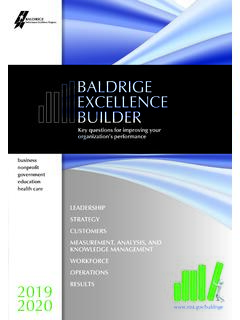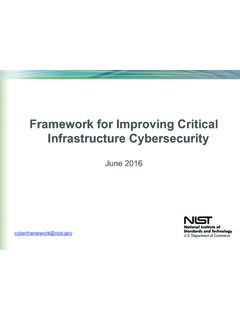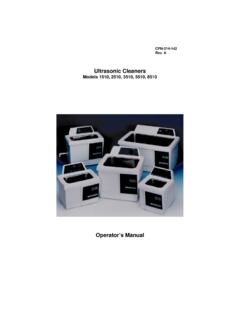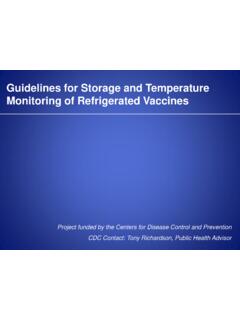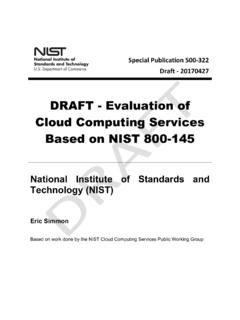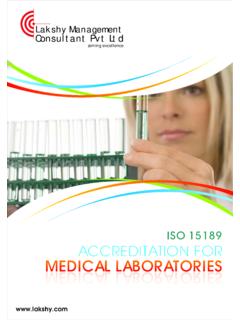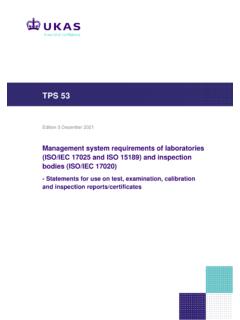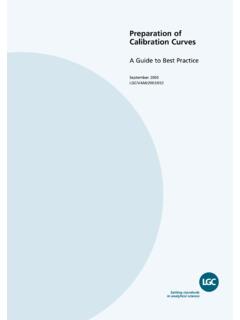Transcription of GMP 11 Assignment and Adjustment of Calibration Intervals ...
1 GMP 11 2019 Page 1 of 9 This publication is available free of charge from: GMP 11 Good Measurement Practice for Assignment and Adjustment of Calibration Intervals for Laboratory Standards 1 Introduction Purpose Measurement processes are dynamic systems and often deteriorate with time or use. The design of a Calibration program is incomplete without some established means of determining how often to calibrate instruments and standards. A Calibration performed only once establishes a one-time reference of uncertainty. Periodic recalibration detects uncertainty growth, serves to reset values while keeping a bound on the limits of errors and minimizes the risk of producing poor measurement results. A properly selected interval assures that an item will be recalibrated at the proper time. Proper Calibration Intervals allow specified confidence Intervals to be selected and they support evidence of metrological traceability.
2 The following practice establishes Calibration Intervals for standards and instrumentation used in measurement processes. Note: This Good Measurement Practice provides a baseline for documenting Calibration Intervals . This GMP is a template that must be modified beyond Section to match the scope1 and specific measurement parameters and applications in each laboratory. Legal requirements for Calibration Intervals may be used to supplement this procedure but are generally established as a maximum limit assuming no evidence of problematic data. For legal metrology (weights and measures) laboratories , no Calibration interval may exceed 10 years without exceptional analysis of laboratory measurement assurance data. Associated analyses may include a detailed technical and statistical assessment of historical Calibration data, control charts, check standards, internal verification assessments, demonstration of ongoing stability through multiple proficiency tests, and/or other analyses to unquestionably demonstrate adequate stability of the standards for the prescribed interval.
3 Extended Calibration Intervals in legal metrology laboratories recognized by the NIST Office of Weights and Measures, must approved by NIST OWM. (See also GLP 4). 1 The laboratory scope is also called Calibration and measurement capability (CMC). The CMC includes 1) measurement parameters, 2) range of nominal values, 3) associated expanded uncertainties, and 4) documented and validated Calibration methods. GMP 11 2019 Page 2 of 9 This publication is available free of charge from: Prerequisites Calibration history and valid Calibration certificates, with suitable Calibration providers and sufficiently small uncertainties, for all laboratory standards. Up-to-date measurement assurance and uncertainty data, with adequate degrees of freedom, for all measurement processes in the laboratory that match the laboratory Scope.
4 Expected tolerance limits where applicable. Safety No outstanding safety concerns 2 Methodology Summary Recommended Calibration Intervals are based on various examples of metrological traceability as described in GMP 13, Good Measurement Practice for Ensuring Metrological Traceability. As data is collected and evaluated, the laboratory technical manager may adjust the Calibration Intervals to ensure that measurement results are not invalidated by the Intervals selected according to this procedure. Apparatus None. Procedure Identification of Parameters The laboratory must identify all measurement parameters associated with the Scope of calibrations (and tests) that will be performed in the laboratory. All standards used in a Calibration process must be assessed to determine their level of significance and to minimize the risk of producing erroneous results on Calibration certificates.
5 Standards are identified as being critical parameters or secondary parameters. Critical Parameters Components that contribute more than 25 % of a measurement s uncertainty are identified as critical parameters with a higher risk for impacting the measurement results. To ensure an accurate GMP 11 2019 Page 3 of 9 This publication is available free of charge from: evaluation of performance, Calibration Intervals are determined to meet a 99 % reliability target. Secondary Parameters Components that contribute less than 25 % but more than 1 % of a measurement s uncertainty are identified as secondary parameters. Secondary parameters are assigned Calibration Intervals designed to meet a 95 % reliability target. Assignment of Initial Intervals Assignment of initial Intervals is based on examples and recommendations given in this GMP as maximum limits.
6 Otherwise, an initial interval is equivalent to the amount of time that passes before a metrologist makes the first observation of a result lying outside the warning limits of a control chart when the investigation yields no apparent correctable cause or when results from proficiency tests fail the normalized error assessment (or when the observed bias exceeds the laboratory uncertainty), or the maximum authorized through law or technical review. Initial Intervals Additional Standards A Calibration program and periodic Calibration interval must be documented for all standards used in the laboratory to comply with the definition and interpretation of metrological traceability. Statements such as as needed are not acceptable alone without additional qualifications. A statement such as calibrations are conducted on an annual basis and may be extended based on demonstrated control through technical and statistical analysis of historical Calibration data, control charts, surveillance testing, and multiple interlaboratory comparisons, but will not exceed five years would be acceptable.
7 Absence of Control Charts or Measurement Assurance Data If no initial measurement assurance data is available, the laboratory s Technical Manager should assign initial Intervals based on guidance and limits provided in this GMP. Intervals may be adjusted based on adequate data and criteria in Section and NIST recommendations. Lacking adequate data for setting and adjusting Calibration Intervals is a risk that must be addressed by the laboratory. Tracking and Scheduling The laboratory must have a program of documenting and monitoring Calibration status and scheduling calibrations on the defined Intervals . Examples include software systems that flag past-due standards prior to use, scheduling on a calendaring system, or periodic reviews to monitor the GMP 11 2019 Page 4 of 9 This publication is available free of charge from: Calibration status prior to regular management reviews so that adequate resources are available to obtain calibrations in a timely manner and to prevent the use of standards after their Calibration due date(s).
8 Adjustment of Intervals Intervals may be adjusted when determined to be necessary by the laboratory s Technical Manager based on adequate data, valid technical and statistical analysis, and documentation of the assessment. Subsequent Intervals may be adjusted based on documented analysis of adequate measurement assurance data, demonstrated control through surveillance assessments, and ongoing stability as demonstrated through multiple interlaboratory comparisons or proficiency tests. Calibration Intervals may be lengthened or shortened by performing a technical and statistical analysis, taking the following factors into consideration as appropriate, and fully documenting the data and assessment: Calibration history; measurement assurance data; interlaboratory comparisons; data for the population of similar standards, equipment or technologies; NIST recommendations; statistical analysis methods; and manufacturer s recommendations.
9 Inadequate reasons for adjusting Intervals might include failure to have an adequate system for tracking due dates, lack of funding for suitable calibrations, loss of competent staff, or other related operational risks. Extending Calibration Intervals must be based on valid, technically supported, and documented assessments to ensure that metrological traceability is supported for all measurement results provided by the laboratory. 3 Assignment of Uncertainty The uncertainty associated with the establishment of Calibration Intervals is not included as a part of the uncertainties associated with the respective measurement SOPs. See SOP 29 for calculating uncertainties for standards and measuring instruments. GMP 11 2019 Page 5 of 9 This publication is available free of charge from: 4 Calibration Intervals for the Laboratory Scope As this document is a template, the laboratory may eliminate all examples in this section and reference another laboratory document that combines metrological traceability information and calibrations in one file if it completely states Calibration Intervals .
10 It is NOT recommended to include Calibration Intervals in the laboratory Quality Manual to ensure that updates are regularly implemented when calibrations are performed without excessive document approval requirements. The tables of Calibration Intervals noted in this GMP may be combined with the tables of reference, working, and check standard tables from the worksheets and hierarchies of GMP 13 to minimize the need for multiple tracking methods in the laboratory. In the following sections, where Lab or Accredited Lab is noted, the measurement capability must be noted on the Scope of the laboratory performing the measurements and suitable supplier evaluations must be in place. For each level of Calibration , a higher-level Calibration is required for check standards. Examples for Mass Mass Critical Parameters Balance and Measurement Process Performance It is important to keep measuring equipment clean and in good working condition.
